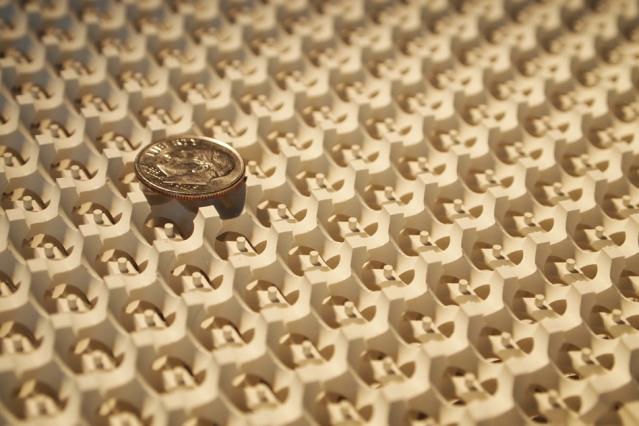Researchers at MIT have led an international team of physicists to directly observe “Weyl points” for the first time. This finding could help the development of new types of optical devices and high-power single-mode lasers.
 The gyroid surface with a dime on top. Image: Ling Lu and Qinghui Yan
The gyroid surface with a dime on top. Image: Ling Lu and Qinghui Yan
Physicist Hermann Weyl had, in 1929, predicted the existence of a type of massless particle that has in its energy spectrum a singular point known as the “Weyl point.”
For a long period of time, neutrinos, which are subatomic particles, were considered to be the massless particles predicted by Weyl. However, in 1998, it was discovered that neutrinos had a small mass. Researchers have written thousands of papers about the theoretical particles before now, but hopes of ascertaining the existence of these particles had not been possible.
“Every single paper written about Weyl points was theoretical, until now,” says Marin Soljačić, a professor of physics at MIT. Soljačić is the senior author of a paper that confirms their detection, which has been published in the journal Science.
A research teams from Princeton University and elsewhere have also independently detected Weyl particles. A paper on their detection has been published in the same Science issue.
The lead author of the research paper, Ling Lu, a research scientist at MIT, states that the elusive points could be considered to be equivalent to magnetic monopoles, which are theoretical entities and are non-existent. Magnetic monopoles would be obtained when a bar magnet is cut in half and the resultant separate magnets should be north and south magnets. However, two shorter magnets with each having two poles are obtained. Lu explains that physicists perform calculations in terms of reciprocal space or momentum space, and not in terms of the ordinary 3D space. Magnetic monopoles can exist in such cases, and their properties would match those of Weyl points.
The MIT team used a photonic crystal material to observe the Weyl points. The measurements for a photonic crystal construction able to produce Weyl points was calculated by Lu. This was done through a gyroid structure configuration, where holes are drilled through the material with precise angles and dimensions. The team then used sophisticated measurements to prove that their prediction matched the requisite characteristics for the specific points.
Lu states that some gyroid structures exist in nature, with some particular butterfly wings being an example. In these cases, the gyroids are self-assembled and their structure is known.
Researchers had, a couple of years earlier, predicted that Weyl points could be generated by breaking the symmetries in “gyroids” in a specific manner. However, this required that the researchers build their materials and then calculate to confirm their prediction. The team then designed crystals that functioned at microwave frequencies. Lu says that a device that worked with visible light could be built based on the same principles. “We know a few groups that are trying to do that,” he says.
Soljačić says that the new findings could increase the benefits of numerous applications. Large-volume single-mode laser devices could be produced using photonic crystals that have such designs. Soljačić says that when a laser is scaled up, light can follow numerous modes, which increases the difficulty of separating a specific single desired mode for the laser beam. This curtails the deliverable laser beam's quality.
But with the new system, “No matter how much you scale it up, there are very few possible modes,” he says. “You can scale it up as large as you want, in three dimensions, unlike other optical systems.”
This issue of scalability in optical systems is “quite fundamental,” Lu says; this new approach offers a way to circumvent it. “We have other applications in mind,” he says, to take advantage of the device’s “optical selectivity in a 3-D bulk object.” As an example, a material block would allow a light of a specific color and angle, while blocking the others.
“This is an interesting development, not just because Weyl points have been experimentally observed, but also because they endow the photonics crystals which realize them with unique optical properties,” says Ashvin Vishwanath, a professor of physics at the University of California at Berkeley who was not involved in this research. “Professor Soljačić’s group has a track record of rapidly converting new science into creative devices with industry applications, and I am looking forward to seeing how Weyl photonics crystals evolve.”
Other researchers who were part of the team included Dexin Ye, Lixin Ran and Zhiyu Wang of Zhejiang University in China; and Liang Fu, assistant professor of physics, and John Joannopoulos, the Francis Wright Davis Professor of Physics and director of the Institute for Soldier Nanotechnologies (ISN) at MIT.
The U.S. Army, the National Science Foundation, the Department of Energy and the Chinese National Science Foundation supported this study.